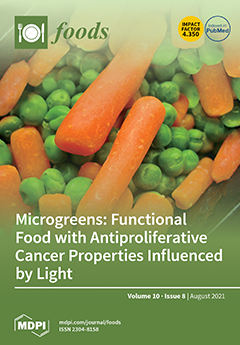Depending on the extraction method, numerous compounds that have specific pharmacological effects can be obtained from
M. alba L. There is a growing scientific interest in health problems related to aging. Efforts to develop safe immune-enhancing pharmaceuticals are increasing. This review aims to
[...] Read more.
Depending on the extraction method, numerous compounds that have specific pharmacological effects can be obtained from
M. alba L. There is a growing scientific interest in health problems related to aging. Efforts to develop safe immune-enhancing pharmaceuticals are increasing. This review aims to summarize and critically discuss the immunity enhancement effects and pharmaceutical efficacy of
M. alba L. extracts. The scientific database search was conducted using Google Scholar, Web of Science, and PubMed until May 2021. Additional articles were identified and obtained from references in the retrieved articles. Ethanol or methanol extraction of various parts of
M. alba L. identified a large amount of phenols and flavonoids, which are effective for immunosuppression, antioxidants, and cardiovascular diseases, and are antibacterial, and anticancer. Water extraction of
M. alba L. enhanced the innate immune response based on immune cell activation. A polysaccharide and an alkaloid related to increased macrophage activity were isolated from
M. alba L. fruit extracts.
M. alba L. fruit water extracts primarily induced the production of pro-inflammatory substances, in model organisms, via TLR4 in immune cells. Water extracts have been shown to be effective in pathogen defense and tumor suppression by enhancing macrophage activity. Based on our literature review on the bioactivity of
M. alba L. fruit extracts, particularly in relation to their immunity enhancement activity, we anticipate that
M. alba-derived pharmaceuticals will have excellent potential in future medical research.
Full article






